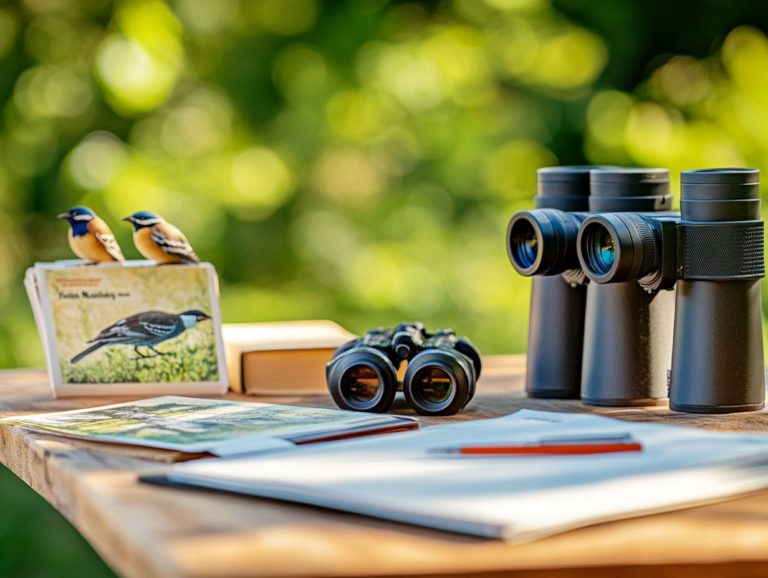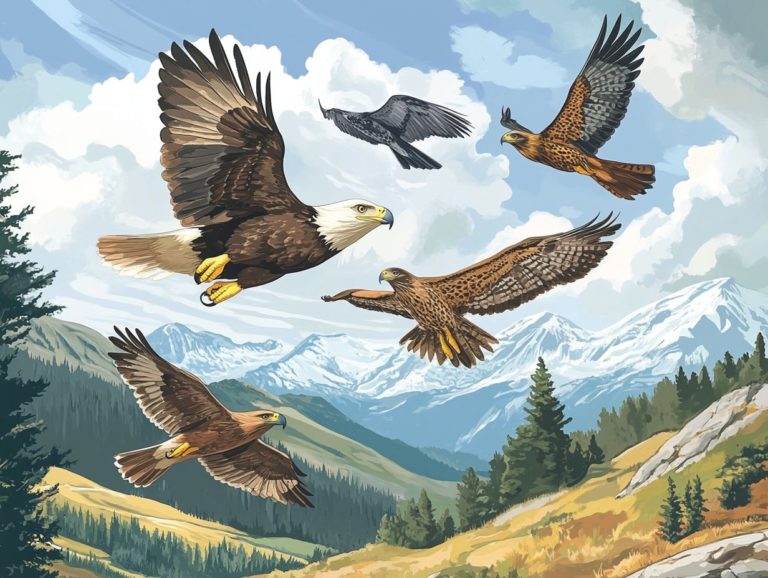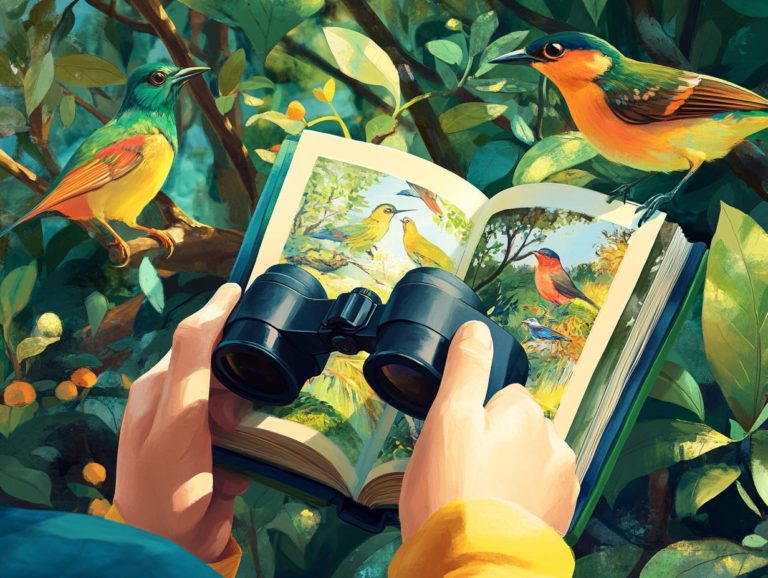The Most Recommended Field Guides by Experts
Ready to explore the wonders of nature? Field guides are your best friends on this journey! They provide invaluable insights and identification tips for the diverse flora and fauna around you, including birds and wildflowers.
This article dives into the most recommended field guides, carefully curated by scientific experts to elevate your adventures in the great outdoors.
From birds and trees to insects, mushrooms, and spring wildflowers, these guides cater to various interests and levels of expertise.
Whether you consider yourself a seasoned naturalist or a curious beginner, you ll find something here to spark your passion for the natural world.
Join us as we showcase the top picks, including must-have references that will enhance your explorations and deepen your appreciation for the beauty of nature.
Contents
- Key Takeaways:
- 1. The Sibley Guide to Birds
- 2. National Audubon Society Field Guide to North American Birds
- 3. Peterson Field Guide to Birds of North America
- 4. The Sibley Guide to Trees
- 5. National Audubon Society Field Guide to Trees
- 6. National Audubon Society Field Guide to Insects and Spiders
- 7. National Audubon Society Field Guide to Mammals
- 8. National Audubon Society Field Guide to Reptiles and Amphibians
- 9. National Audubon Society Field Guide to Mushrooms
- 10. National Audubon Society Field Guide to Rocks and Minerals
- 11. Kaufman Field Guide to Insects of North America
- 12. Kaufman Field Guide to Birds of North America
- 13. Kaufman Field Guide to Nature of the Midwest
- 14. National Geographic Field Guide to the Birds of North America
- 15. National Geographic Field Guide to the Trees of North America
- Frequently Asked Questions
- What are the most recommended field guides by scientific experts?
- Why are these particular field guides considered the best for nature lovers?
- Are these field guides specific to certain regions or areas in North America?
- Do these field guides cover a wide range of species, including flora and fauna?
- What makes these field guides special?
- Where can I purchase these best-selling guides and recommended field guides?
Key Takeaways:

- The Sibley Guide to Birds is highly recommended by experts for its comprehensive and detailed information on bird identification, behavior, and habitats.
- Kaufman Field Guide to Birds of North America is a top choice for its user-friendly layout and beautiful illustrations.
- National Audubon Society Field Guides cover a wide range of species, from birds to trees to rocks, making them a valuable resource for nature enthusiasts and professionals.
1. The Sibley Guide to Birds
The Sibley Guide to Birds is a comprehensive field guide. It combines breadth, depth, and elegance, making it an indispensable reference for both amateur naturalists and seasoned birdwatchers keen on exploring the rich avian diversity of North America.
Within its pages, you ll find stunning full-color photographs, detailed notes, and identification tips that will help you recognize several species, understand their conservation status, and gain valuable ecological insights.
You ll appreciate how well organized its grouping of birds is, allowing for easy navigation through different species a significant improvement over earlier editions. What sets the Sibley Guide apart is its emphasis not just on identification, but also on the behavioral and ecological context of each species.
This holistic approach has made it vital for outdoor programs and educational initiatives within local communities. It nurtures a deeper understanding of avian life and promotes conservation efforts. Educators frequently recommend it for its accessibility and rich information, helping to cultivate ecological literacy and inspire a passion for birdwatching among diverse audiences.
2. National Audubon Society Field Guide to North American Birds
The National Audubon Society Field Guide to North American Birds is an essential reference for any nature lover passionate about birds. It offers a wealth of insights into the habits and habitats of various species across North America, complete with updated guides, range maps, and new categories of knowledge.
This guide organizes information by regions, making it user-friendly for local communities and birdwatchers alike. It doesn’t just stop at identification; it also champions the importance of avian conservation and the role of local book retailers in promoting wildlife guides.
By collaborating closely with scientific experts, the guide synthesizes the latest research findings. You ll receive current data on bird populations, migration patterns, and the checklist of species. Getting updated information is crucial for effective conservation efforts!
For nature lovers like you, this guide is more than just a book; it’s an invaluable tool that deepens your understanding of local ecosystems, including flora and fauna, while fostering a strong sense of responsibility towards protecting these remarkable creatures.
3. Peterson Field Guide to Birds of North America
The Peterson Field Guide to Birds of North America is a timeless gem in bird literature. It is celebrated for its clear identification notes and stunning photographs, making it a great example of the top features to look for in a bird field guide that capture the beauty of common species.
This guide empowers you, the amateur naturalist, to connect deeply with the natural world around you.
Its innovative approach to how birds are categorized, including taxonomic orders, has transformed the way bird species are classified. It serves as an insightful resource for grasping avian relationships. The guide’s thoughtfully designed layout invites you to explore the nuances of bird behavior and habitats, enhancing your appreciation as an enthusiast.
When compared to other prominent guides like Sibley, Kaufman, and Princeton University publications, which also boast excellent visuals and information, Peterson’s distinctive style and systematic content arrangement have left a lasting mark on birdwatching culture. It offers an engaging experience that resonates with both novices and seasoned birders, making each outing a journey of discovery into the natural world.
4. The Sibley Guide to Trees
The Sibley Guide to Trees is your go-to reference for exploring the rich tapestry of North America’s flora. It covers seasonal color changes and wildflower identification.
With its stunning illustrations and photographs, including digital photography, this guide beautifully captures the intricacies of various tree species while offering valuable information about ecosystems.
But it doesn t stop at mere identification. Explore the fascinating world of how trees transform through the seasons! Understand the journey of forests over time.
This guide is essential for educating your local community about the importance of native species and the effects of invasive ones, nurturing greater appreciation for the environment and inspiring conservation efforts through outdoor programs.
5. National Audubon Society Field Guide to Trees

The National Audubon Society Field Guide to Trees is an essential companion for those who cherish the natural world. It enhances your understanding of the intricate relationship between trees and local ecosystems. This guide offers detailed ecological insights, range maps, and identification notes for various tree species found across North America.
What sets this guide apart is its unwavering commitment to conservation, making it a must-have reference for environmentalists and nature lovers alike. It invites you to appreciate not only the beauty of these trees but also their vital roles within local ecosystems.
The guide supports many outdoor programs designed to educate communities about the importance of biodiversity and the role of local communities in conservation. This encourages a hands-on approach to environmental stewardship, empowering individuals to take action in preserving their natural surroundings.
Through these initiatives, you can cultivate a genuine appreciation for nature while actively participating in the preservation of your local habitats and learning about the field guide evolution.
Get your guide today and start your adventure in nature!
6. National Audubon Society Field Guide to Insects and Spiders
Dive into the fascinating world of insects and spiders! The National Audubon Society Field Guide to Insects and Spiders is your go-to reference for identifying these intriguing creatures. It features stunning photographs and illustrations that enhance your understanding of local ecosystems.
Insects and spiders are essential players in our environment. They are vital for nutrient cycling and pollination, and they serve as crucial food sources for many species. Their presence helps maintain the balance within food webs and contributes to soil health and the regeneration of plant life, showcasing the importance of biodiversity.
By engaging with educational programs that spotlight these creatures, local communities can reap tremendous benefits. These initiatives foster environmental stewardship and encourage collective conservation efforts, making them invaluable for local book retailers and wildlife guides. This guide is an essential resource for educators, empowering them to inspire wonder and responsibility about local biodiversity in students and community members.
7. National Audubon Society Field Guide to Mammals
The National Audubon Society Field Guide to Mammals is an essential resource for wildlife enthusiasts. It offers in-depth species information, conservation status, and ecological insights into the diverse mammals of North America.
This comprehensive guide helps you identify the various mammals inhabiting different ecosystems. It reveals their significant roles within the broader environmental context and highlights the importance of conservation. You ll find insights into the threats faced by certain species, providing a clearer understanding of their role in maintaining ecological balance.
It s a valuable educational tool that encourages appreciation and engagement with local wildlife. This guide uniquely combines scientific research with practical advice, making it essential whether you’re a casual observer, a dedicated wildlife advocate, or an amateur naturalist.
8. National Audubon Society Field Guide to Reptiles and Amphibians
The National Audubon Society Field Guide to Reptiles and Amphibians invites you to explore the rich diversity of reptiles and amphibians in North America. With detailed illustrations and beautiful photographs, this guide aids in identification while offering ecological insights.
Reptiles and amphibians are vital for the health of our ecosystems. They regulate pest populations and serve as both predators and prey within their habitats. However, many of these species face significant challenges due to habitat loss, climate change, and pollution, highlighting the urgent need for effective conservation strategies.
This guide goes beyond identification; it emphasizes the critical importance of protecting these species. It aims to educate local communities about their ecological roles. Through hands-on activities and outreach programs, it encourages your participation in conservation efforts, fostering a deep connection with your local environment.
Grab your copy today and unlock the secrets of local wildlife!
9. National Audubon Society Field Guide to Mushrooms
The National Audubon Society Field Guide to Mushrooms stands as a comprehensive resource that invites you into the captivating realm of fungi. It provides clear identification notes and ecological insights that are essential for grasping their vital role in ecosystems.
What truly elevates this guide is its meticulous approach to helping you distinguish between edible and inedible species, serving as a crucial safety measure for anyone eager to embark on foraging adventures. With practical tips and vibrant nature photography, it empowers you whether as an amateur naturalist or a member of a local community to cultivate a deeper appreciation for your natural surroundings.
This knowledge sharpens your foraging skills and nurtures a sense of environmental stewardship. It encourages you to adopt a responsible and informed approach to mushroom gathering. As you explore the diverse habitats and intricate relationships fungi maintain with various plants and animals, you become better equipped to engage with and preserve the ecosystems around you, including the flora and fauna that thrive in these areas.
10. National Audubon Society Field Guide to Rocks and Minerals

The National Audubon Society Field Guide to Rocks and Minerals is an essential educational resource for you, offering detailed identification notes and breathtaking nature photography that invites you to explore the amazing geological wonders of North America.
This guide plays a crucial role in understanding how ecosystems change over time. The interplay of rocks and minerals aids in soil formation and profoundly influences ecosystems. As you examine these elements, you gain valuable insights into how habitats evolve and sustain diverse plant and animal life.
This guide is a cornerstone for educational programs, allowing communities to engage in enriching, hands-on learning experiences like the outdoor programs offered by local institutions. Such initiatives inspire environmental stewardship and cultivate awareness of local biodiversity and its intricate connections with geological features, highlighting how different species are categorized.
11. Kaufman Field Guide to Insects of North America
The Kaufman Field Guide to Insects of North America offers you a remarkably user-friendly approach to insect identification, featuring clear photographs and insightful notes that make it a delight for both novices and experienced naturalists, showcasing several species across various taxonomic orders.
This guide sets itself apart with its extensive coverage of over 1,200 species, coupled with a commitment to providing ecological insights that deepen your understanding of insect behavior and habitats. Unlike many other insect guides that merely focus on identification, the Kaufman guide enriches your experience with valuable contextual information, allowing you to appreciate the vital roles insects play in their ecosystems, particularly in their interactions with flora and fauna.
Its focus on community education encourages a deeper connection between you and the natural world, empowering you to engage in conservation efforts and truly appreciate the diverse insect life that surrounds you through wildflower identification and other programs.
12. Kaufman Field Guide to Birds of North America
The Kaufman Field Guide to Birds of North America is a great resource for bird identification. It features insightful notes and stunning imagery, making it an ideal companion for your birdwatching adventures.
This guide avoids overwhelming readers with excessive details. Instead, it focuses on user-friendliness, allowing beginners to easily navigate its pages.
With its organized format and clear visuals, this guide fosters a love for birdwatching. It offers simple tips that encourage you to observe nature closely.
This guide also raises awareness about different bird species and their habitats. It inspires you to advocate for wildlife protection.
13. Kaufman Field Guide to Nature of the Midwest
The Kaufman Field Guide to Nature of the Midwest is your essential resource for understanding the region’s rich biodiversity. With ecological insights and stunning photography, it captivates nature lovers.
This guide catalogs various plant species, including spring wildflowers and deciduous trees. It also highlights fascinating local animals, from migratory birds to elusive mammals.
Aspiring naturalists will find its user-friendly structure valuable for improving species identification. This connection to nature enriches your learning journey and supports conservation efforts.
14. National Geographic Field Guide to the Birds of North America
The National Geographic Field Guide to the Birds of North America is a must-have for birdwatchers, and it pairs well with other resources like top field guides for birding in national parks. It offers clear identification notes and detailed information on diverse species.
Its stunning photographs capture the vibrant colors and details of each bird. The full-color images enhance your understanding.
The guide emphasizes conservation status, informing you about challenges faced by species. It s an essential resource for those wanting to learn more about bird ecology.
By deepening your appreciation for these creatures, it promotes responsible birdwatching. This guide enhances your understanding of their vital role in the ecosystem.
15. National Geographic Field Guide to the Trees of North America

The National Geographic Field Guide to the Trees of North America is your essential companion for navigating the rich tapestry of tree species across the continent. It offers not only detailed identification notes but also stunning visuals and ecological insights that truly bring these giants to life.
This guide goes beyond merely cataloging trees. It highlights both native and invasive species that populate diverse ecosystems, all while showcasing the seasonal color changes that lend each tree its unique charm throughout the year.
By showing how plants and animals interact, it becomes an invaluable asset in conservation efforts aimed at preserving biodiversity and educating local communities.
Serving as a vital resource for local communities, this guide supports educational programs that foster tree stewardship and environmental awareness. Through hands-on learning and exploration, dive into the exciting world of nature! Deepen your appreciation for the essential roles trees play in keeping our ecosystems healthy, particularly through participation in outdoor programs.
Frequently Asked Questions
What are the most recommended field guides by scientific experts?
According to experts in the field, the most recommended field guides are the Peterson Field Guides, National Audubon Society Field Guides, and Golden Guides, known for their remarkable breadth in coverage.
Why are these particular field guides considered the best for nature lovers?
These field guides are considered the best because they contain accurate and detailed information, high-quality illustrations, and are user-friendly for both beginners and experienced naturalists. They are essential references for anyone passionate about the natural world, including the top 10 field guides for North American birds.
Are these field guides specific to certain regions or areas in North America?
Yes, some of these field guides have editions that are specific to certain regions or areas, such as the Peterson Field Guides for Eastern/Central/Western North America, or the National Audubon Society Field Guides for specific states or regions.
Do these field guides cover a wide range of species, including flora and fauna?
Yes, these field guides cover a wide range of species, including birds, mammals, insects, plants, and more. They are also constantly updated guides to include new species and changes in classification of living things.
What makes these field guides special?
These field guides, such as those from the National Audubon Society and Princeton University, are recommended by scientific experts because they are comprehensive, reliable, and are frequently updated to reflect the latest information and research. For those interested in exploring further, the top bird field guides for international travel include the latest checklist on conservation status and ecological insights. They are also easy to use in the field, with clear and concise descriptions, beautiful illustrations, and full-color photographs.
Where can I purchase these best-selling guides and recommended field guides?
These field guides can be purchased at most major bookstores, local book retailers, outdoor retailers, and online retailers. You can also find them at local nature centers or parks, or borrow them from your local library, where local communities often hold outdoor programs.






